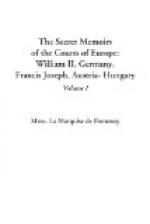According to these sumptuary decrees gentlemen who are invited to entertainments at court, and who for any reason have no right to military, naval or civil service uniform, are compelled to appear in a species of court dress, consisting of a coat cut after the fashion of the last, rather than of the present century. Its color is black, or dark blue, as are also the revers, the collar and the cuffs; with it are worn black, tight fitting knee breeches, black silk stockings, and low patent leather shoes with gold buckles. A three-cornered chapeau, without feathers, and a court sword, complete this costume.
The emperor likewise directed that all officials of the court and the civil service, namely, every man who did not happen to belong either to the army or to the navy, should wear at court balls and at all great state entertainments, white knee breeches, and white silk stockings, with low, gold-buckled shoes, in lieu of the blue, black, or white gold-laced trousers that had until then been habitually worn with the gold-embroidered swallow-tail coat, which constitutes the uniform of the German civil service, and of court officialdom. Until that time, the only European court at which knee breeches had been insisted upon at court and state entertainments, was that of Great Britain. They were likewise de rigueur at the Tuileries during the reign of Napoleon III. The kaiser, however, came to the conclusion that continuations of this kind gave a more brilliant and dressy appearance to court functions than long trousers, and accordingly the latter are barred, save in the case of officers of the army and navy.
At the imperial court of Berlin there are four types of receptions or cours, the latter being the French word which has clung to these state functions ever since the reign of Frederick the Great. They are the “Defiler-Cour,” the “Spiel-Cour,” the “Sprech-Cour” and the “Trauer-Cour.” The first, namely, the “defiler cour”—from the French word defiler, to file past—is the Berlin counterpart of Queen Victoria’s drawing-rooms at Buckingham Palace in London, and is held once a year for the purpose of presenting debutantes, brides and ladies whose husbands have recently been promoted, or raised to the rank of nobility. They pass one by one before the throne, curtsy profoundly to each of their majesties, while the grand chamberlain mentions their names, and then leave the imperial presence by a side exit. No one kisses the empress’s hand, as is the case with Queen Victoria in England, nor are the presentees compelled to back out of the imperial presence, as at Buckingham Palace. The court dress of debutantes at Berlin is not necessarily white, though that is the hue most affected. The long court train may be of an entirely different material and color from the dress itself, if the wearer pleases, the only stipulation made being that the richness and splendor of the fabric must be beyond question. An indispensable feature of the toilette is the so-called “barbe,” a sort of tiny lace veil, suspended on each side of the coiffure, about two inches in width. The lace of course must be real, though the kind is left to the wearer’s choice. It is generally white Spanish point, Alencon, or Point d’Angleterre.




